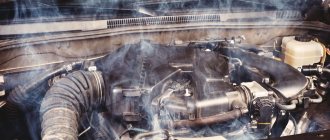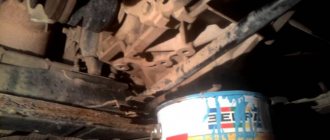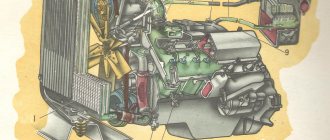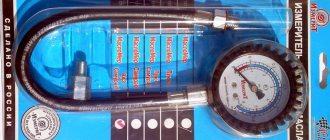From the history
From the fall of 1961 to January 1967, Gorky produced the GAZ 53 with the index “F”; the GAZ 53F was powered by the six-cylinder GAZ 51 engine. Although the engine was somewhat improved at that time, it had significant drawbacks.
The internal combustion engine was already obsolete by that time. The lower arrangement of the valves gave low efficiency and low power; the engine was inconvenient to maintain and repair. Even adjusting the valves was a problem, and it took a lot of time to adjust them. The cast iron structure had considerable weight, the motor had a relatively short mileage. Everything was moving towards replacing the outdated design with something more acceptable.
Example of an engine for GAZ 53
In April 1958, in the city of Zavolzhye, Gorky Region, a new engine plant began producing engines and spare parts for them. ZMZ was a subsidiary of GAZ and made engines for this enterprise. In parallel, internal combustion engines were produced for the Ulyanovsk and Moscow Automobile Plants.
At the end of 1958, the Trans-Volga enterprise mastered the casting of aluminum alloys, and the plant began to develop the production of new light metal parts.
At the time, this was a big step forward in the automobile industry.
First, ZMZ designed a V-shaped 8-cylinder engine for the GAZ 13 “Chaika” (ZMZ 13). The engine had a power of 195 horsepower and ran on high octane gasoline (Ai-93 or Ai-95). Almost immediately, the ZMZ 41 internal combustion engine (140 hp) was developed. ZMZ 41 ran on “seventy-sixth” gasoline. This engine was installed on the Volgas of the special services.
This is what a V-shaped 8-cylinder internal combustion engine looks like
This is interesting: How much oil is in a Nissan Terrano engine
Motor maintenance
Internal combustion engines belonging to the ZMZ-53 family are distinguished by a good service life and reliability, however, like any other power units, they require regular maintenance. Such preventive measures include:
In order for the GAZ-53 engine to work as much as possible without malfunctions, it is necessary to regularly diagnose it, correct problems in a timely manner and fill only with high-quality engine oil.
Engine diagnostics
Regular inspection is necessary for the cylinder block. If its fastenings become loose, tighten the nuts. Before carrying out such work, all the coolant is drained from the system and the fastening of the intake pipe is loosened - this makes it possible to prevent the tightening of one cylinder head from affecting the others.
After such procedures, the nuts are tightened with a torque wrench. The manufacturer recommends performing this type of work for the first three maintenance services, then its frequency can be reduced to every second.
The GAZ-53 engine does not require repairs provided that high quality lubricants and fuel are used. In this case, the carbon deposits formed on the pistons and inside the combustion chamber will be small and will not have any effect on the operation of the engine.
Failure to follow simple rules can lead to detonation, increased consumption and decreased power.
The design of a car engine for GAZ-53
The main advantage of the GAZ-53 engine is its efficiency and decent technical potential.
- The base of the GAZ-53 gasoline engine is a simple carburetor with a “V” shaped installation of cylinders. This arrangement increases engine power and torque.
- The next distinguishing feature is the screw exhaust valve and high turbulence chamber in the cylinder heads, which improves efficiency.
- The presence of an exhaust gas recirculation system, which reduces the amount of emissions into the atmosphere.
- Carter.
- Gear box.
- Combined lubrication system.
- The liquid-based cooling system ensures smooth operation even in hot weather.
Characteristics of ZMZ 53A
Starting from 1966, the ZMZ 53 engine was installed as standard on GAZ 53A and GAZ 53 12 vehicles. It had an overhead valve arrangement, and the model used a K 126B carburetor. Later a different carburetor was installed (K 135)
Unlike the ZMZ 41, the 53rd engine has a smaller cylinder volume and piston stroke. Some people claim that the parts of these internal combustion engines are interchangeable, but this is absolutely not true. The engines even have different cylinder blocks, not to mention the piston group, crankshaft and cylinder head. The difference in the blocks is that the seats for the cylinder liners are of different diameters, so replacing one block with another will be extremely problematic.
Technical characteristics of ZMZ 53A:
- Engine volume is 4.25 l (ZMZ 41 has 5.53 l);
- Piston diameter 92 mm (for ZMZ 41 - 100 mm);
- The piston stroke is 80 mm (for ZMZ it is 41 - 88 mm);
- The diameter of the piston pin is 25 mm (for ZMZ it is 41 - 28 mm);
- Engine power 115 hp (ZMZ has 41 - 140 hp);
- The compression ratio is 6.7 (ZMZ 41 has 6.7).
From all of the above, it becomes clear that engine parts are not interchangeable. You can only rearrange the entire power unit.
Engine Specifications
Below are the technical characteristics of the ZMZ 511.1000398 engine for GAZ-53 GAZ-3307 and AI-76
The engine is carburetor, gasoline, with a V-shaped arrangement of cylinders at an angle of 90 degrees and an overhead valve arrangement.
The engine uses cylinder heads with highly turbulent combustion chambers and helical intake ports. All engines use an exhaust gas recirculation system to reduce emissions of harmful substances into the atmosphere. The engines have a clutch housing for a unified gearbox.
- number of cylinders - 8;
- operating mode - 4-stroke;
- compression ratio - 7.6:1;
- working volume, l - 4.25;
- rated power at a crankshaft speed of 3200-3400 1/min, kW (hp) - 92 (125);
- maximum torque at a crankshaft speed of 2000-2500 1/min, N*m (kgf*m) - 294 (30);
- minimum specific fuel consumption g/kW*h (g/l. S.*h) - 286 (210);
- oil consumption for waste, % of fuel consumption - 0.4;
- weight, kg - 262;
- fuel - A-76.
External speed characteristics of the engine.
By complying with all requirements, the GAZ 53 engine will serve you and your children.
Return to contents
Replacing piston rings
The main sign that it is time to change the piston rings is an increase in lubricant consumption. Normally it is 400 g per 100 kilometers. The piston ring set includes steel discs and a cast iron compression ring.
During replacement, the unworn section of the belt is removed from the cylinder liners, and the cylinder head is cleaned of carbon deposits.
The gas distribution mechanism also requires regular diagnostics. Valve clearances are checked only with the engine idling and the pusher lowered all the way.
This is interesting: What kind of gasoline does the Chevrolet Niva run on?
Features of the GAZ 53 engine ignition system
The following indicators depend on the quality of operation of the ignition system elements:
- Spark power.
- Timeliness of its education.
- Complete combustion of the air-fuel mixture.
With stable operation of the power unit, an electrical voltage appears on the electrodes, which is necessary for successful spark formation. If the spark is weak or absent altogether, the power performance of the internal combustion engine decreases and fuel consumption increases. The power of the spark depends on the distance between the electrodes (gaps) and the voltage.
The main reasons leading to malfunctions in the ignition system of the GAZ 53 engine:
- A spark does not form when the coil and commutator overheat. In this case, the engine does not start until the temperature drops so that a spark appears.
- Breakdown and sparking of high-voltage wires.
- Burning contacts of the moving slider on the distributor.
- Burnout of the distributor cap at the spring locations.
- Failure of spark plugs.
In order to prevent engine overheating, it is recommended to adjust the ignition process. To do this, the gaps between the electrodes of the system are adjusted using a special device called a “car strobe”. Using this device, experienced craftsmen adjust and control the ignition timing.
When ignition is early, the following malfunctions occur:
- failure of the cylinder head gasket (breakdown);
- burning out of pistons;
- valves
If sparking is delayed:
- gasoline consumption increases;
- the engine overheats.
Possible malfunctions of the GAZ-53 internal combustion engine
The power unit has breakdowns and malfunctions that are typical for any other engine. To eliminate them, the GAZ-53 engine is completely disassembled and reassembled. The reasons for breakdowns can be different:
- The appearance of knocking of brass liners. This is the most serious malfunction. It is caused by low oil level, wear of all parts, or reduced or completely absent pressure in the system.
- Increased lubricant consumption. Oil can either flow through the seals and connections, or through the piston rings. This could also be caused by a clogged breather.
- Knocking of connecting rod bushings or pistons. Pistons are characterized by burnout of the bottom or failure of the partitions between the rings. The main reason for this is engine overheating.
- Burnout of exhaust valves. They do not burn out by themselves, but you can often encounter wear on the guide bushings. There may be several reasons for this: ingress of engine oil, low quality fuel, or lack of clearance in the valves.
- Burnout of cylinder block gaskets. The reason is overheating of the engine, which can lead to curvature of the surface of the heads.
Correct engine maintenance
The engine itself is good and does not cause any complaints; the main thing is to maintain its technical condition.
This is what the internal combustion engine looks like for a GAZ 53 car
When carrying out maintenance, the cylinder head must be tightened.
But these are the first three technical inspections, then the frequency can be increased and the cylinder head can be tightened after each TO-2.
Don't forget about the temperature.
To help your engine last longer, replace the piston rings as soon as necessary. The car itself will tell you that it is time to replace the piston rings. In this case, after every 100 km. mileage the oil will decrease by about 400 grams. If the oil pressure in the system has dropped, then the problem is in the crankshaft main bearing shells, which also need to be replaced immediately.
Engine for GAZ 53 cross-section
If you decide to replace the bearings, do not be lazy and clean the cavity of the crankshaft connecting rod journals. From time to time, check the timing belt and adjust the valve clearances.
Main malfunctions of ZMZ 53 engines
Like any other engine, ZMZ 53 has its weak points. The modifications here don’t depend on much; all internal combustion engines have identical characteristics.
- insufficient oil pressure in the lubrication system;
- deformation of the intake manifold (“spider”);
- oil leak from the rear main bearing;
- increased oil consumption;
- Under enormous loads, the crankpins of the crankshaft become rough.
Still, the engines in this series are quite durable. Considering the kind of motor oil that is sometimes poured into them, one can only be surprised at the tolerance of the internal combustion engine. Not every foreign-made engine can withstand such abuse.
You often hear “lawn drivers” from drivers. “That’s it, the engine is running out.” So, it can “end” in almost years. Without pressure, with a smoking piston and huge oil consumption, the “lawn” still drives for a long time. Very often, and sometimes for a long time, something knocks on “Gazonov” engines, but what exactly is not clear even after disassembling the unit. Mind-blowing, but true.
Engine overhaul
With proper care, the GAZ-53 engine rarely needs major repairs, but if this does happen, the following malfunctions may be the cause:
- Increased lubricant consumption, and with the replacement of rings the problem remained relevant.
- Low pressure in the lubrication system and knocking noises in the engine.
- Wear of the entire power unit with exhaustion of its working life.
- Engine jamming due to the crankshaft.
Engine repairs can be carried out independently - the manufacturer issues a complete operating manual, in which all steps for changing parts and possible malfunctions and methods for eliminating them are described in detail.
Despite everything, the engines installed on the GAZ-53 are distinguished by good endurance. Considering the various “modifications” of the internal combustion engine and the oils that are sometimes poured into it, one can only be surprised at its performance. Often such an engine can function quietly for years, even if there are strange knocking noises.
There are equipment, cars that become a symbol of the times. When people of the older generation remember the late Soviet era, they also remember this car, Gaz 53. It was produced at the Gorky Automobile Plant.
Production of this car began in the 60s. There were several modifications of this 3rd generation technique. The car was produced until 1993. Over 30 years, more than 4 million cars were produced. A medium-tonnage truck with a capacity of 3 to 4.5 tons became the most popular truck in Soviet times. History Gas 53
rich. This machine served the entire national economy of the USSR for a long time and reliably. The surviving working machines are still used in agriculture, construction sites, and public utilities.
Modifications of Gas 53 were produced in a certain order. From the start of production of the car until 1967, it was branded F. Then a truck with the letter A began to be produced - a more load-bearing vehicle and stronger. Then, in 1984, the Gas 53-19 and 53-27 models were launched. The latter has a propane-powered engine. All cars were produced in parallel, for different needs. Here is a photo of the onboard Gas 53:
This truck became the pride of the Soviet automobile industry. It was also exported abroad. Many countries bought the car. Comfortable, durable. Another modification began to take a load of up to 4.5 tons. Photo Gas 53:










